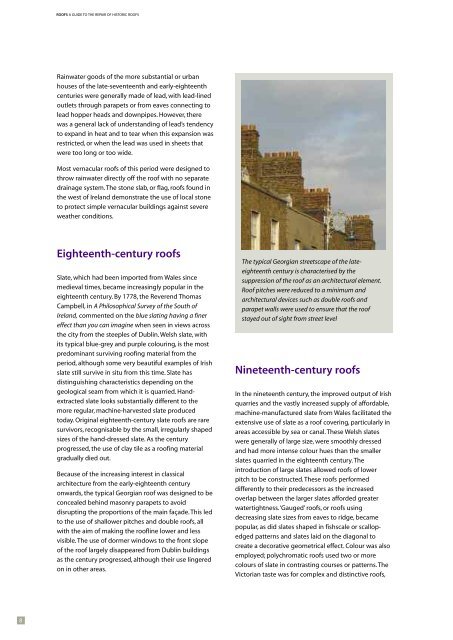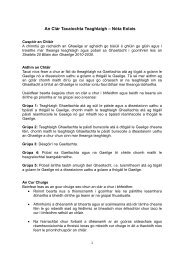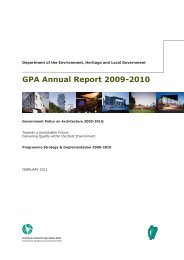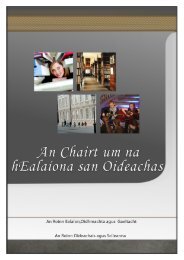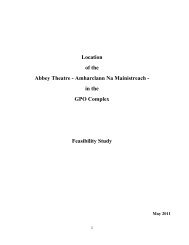A Guide to the Repair of Historic Roofs - Dublin City Council
A Guide to the Repair of Historic Roofs - Dublin City Council
A Guide to the Repair of Historic Roofs - Dublin City Council
You also want an ePaper? Increase the reach of your titles
YUMPU automatically turns print PDFs into web optimized ePapers that Google loves.
ROOFS A GUIDE TO THE REPAIR OF HISTORIC ROOFSRainwater goods <strong>of</strong> <strong>the</strong> more substantial or urbanhouses <strong>of</strong> <strong>the</strong> late-seventeenth and early-eighteenthcenturies were generally made <strong>of</strong> lead, with lead-linedoutlets through parapets or from eaves connecting <strong>to</strong>lead hopper heads and downpipes. However, <strong>the</strong>rewas a general lack <strong>of</strong> understanding <strong>of</strong> lead’s tendency<strong>to</strong> expand in heat and <strong>to</strong> tear when this expansion wasrestricted, or when <strong>the</strong> lead was used in sheets thatwere <strong>to</strong>o long or <strong>to</strong>o wide.Most vernacular ro<strong>of</strong>s <strong>of</strong> this period were designed <strong>to</strong>throw rainwater directly <strong>of</strong>f <strong>the</strong> ro<strong>of</strong> with no separatedrainage system. The s<strong>to</strong>ne slab, or flag, ro<strong>of</strong>s found in<strong>the</strong> west <strong>of</strong> Ireland demonstrate <strong>the</strong> use <strong>of</strong> local s<strong>to</strong>ne<strong>to</strong> protect simple vernacular buildings against severewea<strong>the</strong>r conditions.Eighteenth-century ro<strong>of</strong>sSlate, which had been imported from Wales sincemedieval times, became increasingly popular in <strong>the</strong>eighteenth century. By 1778, <strong>the</strong> Reverend ThomasCampbell, in A Philosophical Survey <strong>of</strong> <strong>the</strong> South <strong>of</strong>Ireland, commented on <strong>the</strong> blue slating having a finereffect than you can imagine when seen in views across<strong>the</strong> city from <strong>the</strong> steeples <strong>of</strong> <strong>Dublin</strong>. Welsh slate, withits typical blue-grey and purple colouring, is <strong>the</strong> mostpredominant surviving ro<strong>of</strong>ing material from <strong>the</strong>period, although some very beautiful examples <strong>of</strong> Irishslate still survive in situ from this time. Slate hasdistinguishing characteristics depending on <strong>the</strong>geological seam from which it is quarried. Handextractedslate looks substantially different <strong>to</strong> <strong>the</strong>more regular, machine-harvested slate produced<strong>to</strong>day. Original eighteenth-century slate ro<strong>of</strong>s are raresurvivors, recognisable by <strong>the</strong> small, irregularly shapedsizes <strong>of</strong> <strong>the</strong> hand-dressed slate. As <strong>the</strong> centuryprogressed, <strong>the</strong> use <strong>of</strong> clay tile as a ro<strong>of</strong>ing materialgradually died out.Because <strong>of</strong> <strong>the</strong> increasing interest in classicalarchitecture from <strong>the</strong> early-eighteenth centuryonwards, <strong>the</strong> typical Georgian ro<strong>of</strong> was designed <strong>to</strong> beconcealed behind masonry parapets <strong>to</strong> avoiddisrupting <strong>the</strong> proportions <strong>of</strong> <strong>the</strong> main façade. This led<strong>to</strong> <strong>the</strong> use <strong>of</strong> shallower pitches and double ro<strong>of</strong>s, allwith <strong>the</strong> aim <strong>of</strong> making <strong>the</strong> ro<strong>of</strong>line lower and lessvisible. The use <strong>of</strong> dormer windows <strong>to</strong> <strong>the</strong> front slope<strong>of</strong> <strong>the</strong> ro<strong>of</strong> largely disappeared from <strong>Dublin</strong> buildingsas <strong>the</strong> century progressed, although <strong>the</strong>ir use lingeredon in o<strong>the</strong>r areas.The typical Georgian streetscape <strong>of</strong> <strong>the</strong> lateeighteenthcentury is characterised by <strong>the</strong>suppression <strong>of</strong> <strong>the</strong> ro<strong>of</strong> as an architectural element.Ro<strong>of</strong> pitches were reduced <strong>to</strong> a minimum andarchitectural devices such as double ro<strong>of</strong>s andparapet walls were used <strong>to</strong> ensure that <strong>the</strong> ro<strong>of</strong>stayed out <strong>of</strong> sight from street levelNineteenth-century ro<strong>of</strong>sIn <strong>the</strong> nineteenth century, <strong>the</strong> improved output <strong>of</strong> Irishquarries and <strong>the</strong> vastly increased supply <strong>of</strong> affordable,machine-manufactured slate from Wales facilitated <strong>the</strong>extensive use <strong>of</strong> slate as a ro<strong>of</strong> covering, particularly inareas accessible by sea or canal. These Welsh slateswere generally <strong>of</strong> large size, were smoothly dressedand had more intense colour hues than <strong>the</strong> smallerslates quarried in <strong>the</strong> eighteenth century. Theintroduction <strong>of</strong> large slates allowed ro<strong>of</strong>s <strong>of</strong> lowerpitch <strong>to</strong> be constructed. These ro<strong>of</strong>s performeddifferently <strong>to</strong> <strong>the</strong>ir predecessors as <strong>the</strong> increasedoverlap between <strong>the</strong> larger slates afforded greaterwatertightness. ‘Gauged’ ro<strong>of</strong>s, or ro<strong>of</strong>s usingdecreasing slate sizes from eaves <strong>to</strong> ridge, becamepopular, as did slates shaped in fishscale or scallopedgedpatterns and slates laid on <strong>the</strong> diagonal <strong>to</strong>create a decorative geometrical effect. Colour was alsoemployed; polychromatic ro<strong>of</strong>s used two or morecolours <strong>of</strong> slate in contrasting courses or patterns. TheVic<strong>to</strong>rian taste was for complex and distinctive ro<strong>of</strong>s,8


